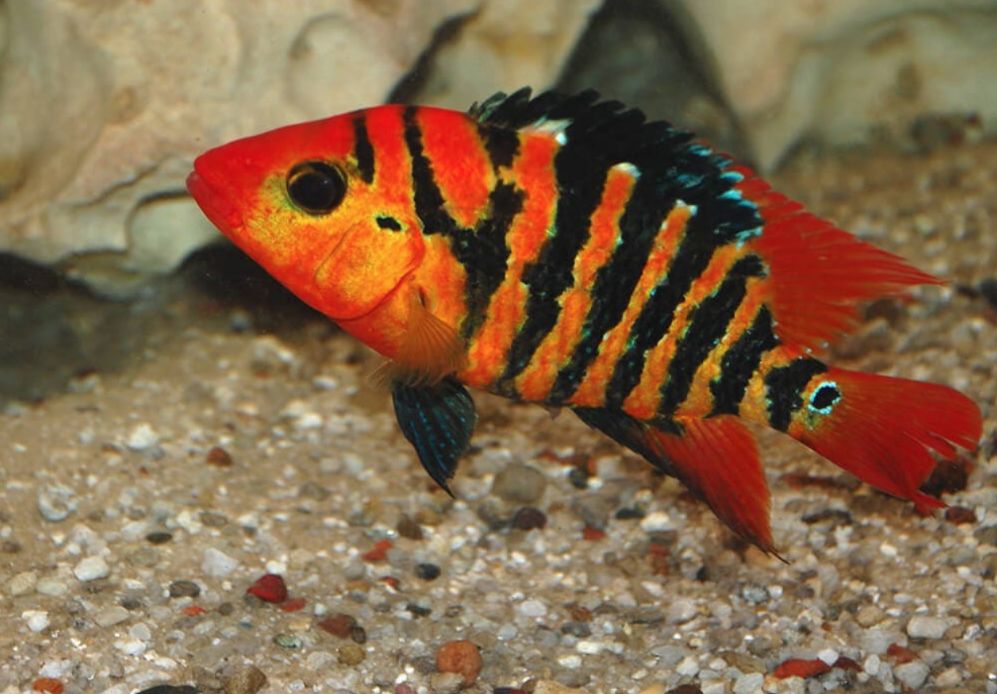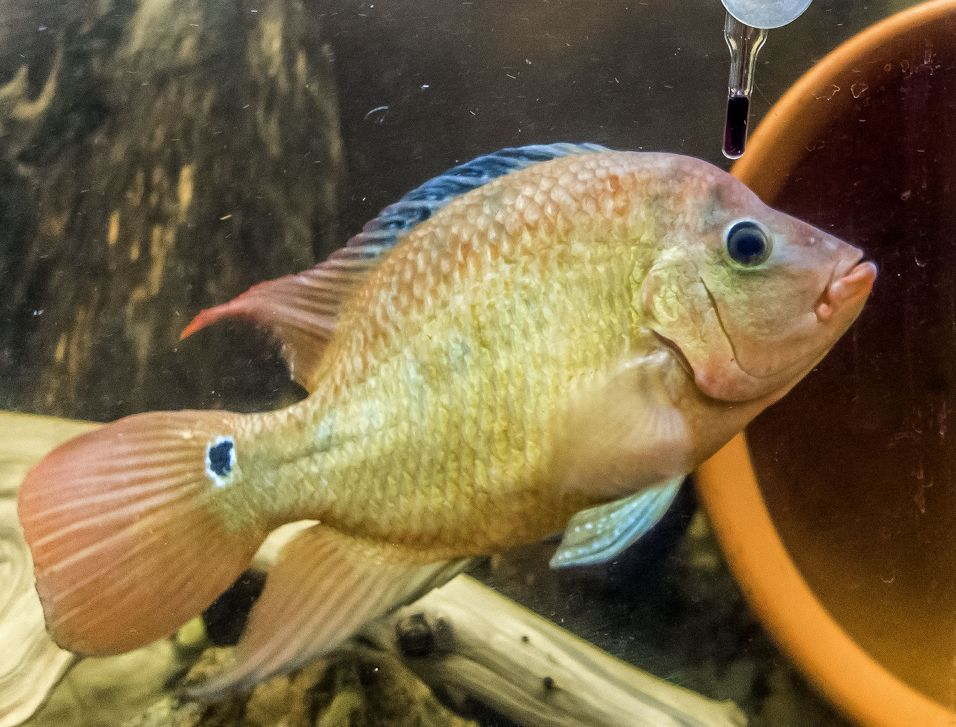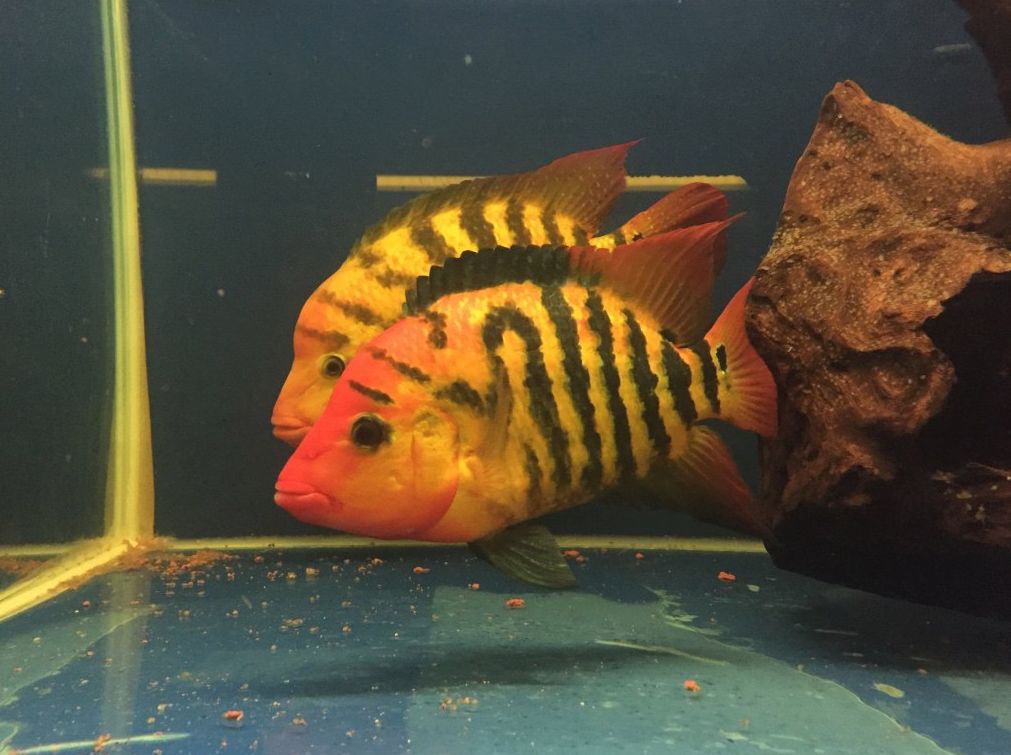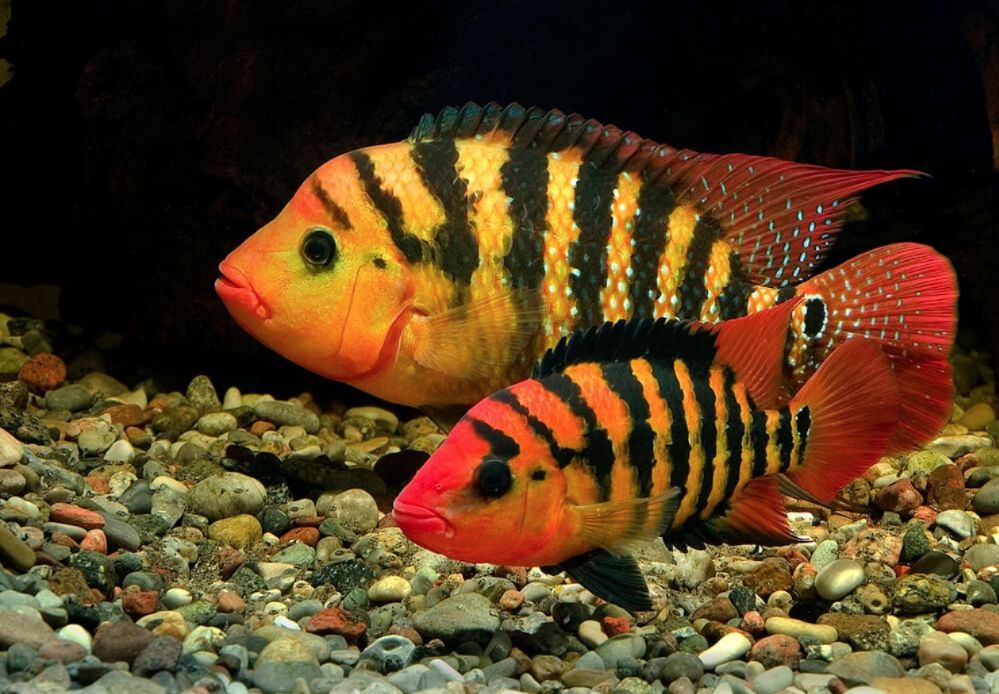The red terror cichlid is a strikingly colorful and large fish from the Cichlidae family, known for its territorial nature. Due to its temperament, it is often best kept in species-specific tanks. While moderately challenging to care for, the red terror cichlid is an excellent choice for aquarists seeking an intelligent and vibrant addition to their aquarium. This species thrives in environments that mimic its natural habitat, and while it can be aggressive, providing ample space and proper tank mates can enhance its well-being. Overall, the red terror cichlid offers a captivating experience for those ready to meet its care requirements.

Contents
Habitat in the wild
The harlequin cichlid, native to the waters of western South America—from the Río Esmeraldas in Ecuador to the Río Tumbes river basin in Peru—has also been reported as an invasive species in Singapore. This cichlid thrives in areas with strong water flow, often swimming in the mid-water column while seeking shelter in indentations and pits beneath submerged tree branches.
In its natural habitat, the harlequin cichlid favors slow-moving or still waters, including rivers, streams, and lagoons. It is commonly found in environments with rocky substrates, submerged roots, and lush aquatic vegetation, which provide essential hiding spots, territorial boundaries, and spawning sites. Cichlasoma festae can inhabit both clear and turbid waters and is typically located in regions with a tropical climate, where temperatures range from 22°C to 28°C (72°F to 82°F). Its diet primarily consists of crustaceans, small fish, and plant matter, reflecting its adaptability in diverse environments.
Description
Size
Red terror cichlids can grow quite large, reaching up to 50 cm (20 inches) in the wild, with females typically maxing out at around 30 cm (12 inches). In aquariums, it’s common for well-cared-for individuals to reach sizes of 25 to 30 cm (10 to 12 inches) or even larger.
Lifespan
The lifespan of a red terror cichlid typically ranges from 10 to 15 years, with some individuals living even longer under optimal conditions. Factors such as quality of care, diet, and environmental stability play a crucial role in determining their longevity.
Color
The female red terror cichlid showcases vibrant red coloring with vertical black stripes and small sparkling blue spots, while her snout is a striking orange-red. In contrast, the male displays a turquoise-green body adorned with orange fins and blue spots on his tail. These vivid colorations not only enhance their beauty but may also change during breeding, making them a captivating addition to any aquarium.
| Characteristic | Description |
|---|---|
| Scientific Name | Parachromis festae |
| Common Names | Red Terror Cichlid, Harlequin cichlid, Festae cichlid, |
| Family | Cichlidae |
| Origin | Western Ecuador and Northern Peru, South America |
| Size | Up to 50 cm (20 inches) |
| Lifespan | 10 to 15 years or more in captivity |
| Coloration | Vibrant red-orange with some black markings |
| Behavior | Aggressive and territorial |
| Aquarium Size | At least 75 gallons (284 liters) for a single specimen |
| Water Parameters | pH: 6.5-8.0, Temperature: 72°F to 82°F (22°C to 28°C) |
| Diet | Omnivorous, feeds on both live and prepared foods |
| Tank Setup | Rocks, driftwood, and plants for hiding and territory |
| Breeding | Substrate spawner, both parents care for the fry |
| Compatibility | Best kept with larger, robust fish and similar species |
| Difficulty | Intermediate to advanced (due to aggression) |

Difficulties in keeping
The red terror cichlid is best suited for experienced aquarists due to its large size and highly territorial nature. While it is relatively undemanding in terms of care, it requires a spacious environment to thrive. It is essential to keep this fish alone in a large species-specific tank to prevent aggression and ensure its well-being.

Care and keeping in a tank
The red terror cichlid is best suited for experienced aquarists due to its large size and highly territorial nature. While it is relatively undemanding in terms of care, it requires a spacious environment to thrive. It is essential to keep this fish alone in a large species-specific tank to prevent aggression and ensure its well-being.
Tank size
Successfully keeping a red terror cichlid requires creating tank conditions similar to its natural habitat. For large and aggressive fish like this, it is crucial to provide ample space, which can help reduce aggression and promote healthy growth. To house a pair of red terror cichlids, you should aim for a tank with a capacity of at least 500 liters (110 gallons), or even larger if you plan to include other fish.
Tank decor
The harlequin cichlid, like other species in its family, often modifies its tank environment to suit its preferences, frequently digging in the substrate and uprooting plants. For the best bottom substrate, small pebbles or granite chippings are ideal.
It’s essential to place stones on the tank floor to create distinct sections and provide caves and rock shelters, offering hiding spots for cichlids that need some solitude. Additionally, incorporating several flat-surfaced stones in different areas can facilitate breeding in community tanks.
Using flower pots to anchor plants can enhance the aesthetic while keeping them stable. When selecting tank plants, opt for hardy, fast-growing varieties with strong root systems, as densely planted areas also serve as excellent shelter for the fish.
Water parameters
Red terror cichlids originate from flowing waters, making them sensitive to accumulated organic waste in their tank. Due to their protein-rich diet, these fish produce significant waste. To maintain high water quality, it’s essential to install a powerful filter with effective biological filtration. Additionally, performing weekly water changes of 20–30% of the total tank volume and regularly cleaning the substrate will help reduce ammonia and nitrate levels.
While red terror cichlids can adapt to various water conditions, they thrive best within specific parameters: a temperature range of 25-28 °C (77-82.4 °F), a pH between 6.0 and 7.5, and a hardness of 4 to 18°dH.
Diet
The harlequin cichlid is a predator, making live food an essential part of its diet. In the wild, it primarily feeds on crustaceans, mussels, and small fish.
In the aquarium, a high-quality specialized food formulated for large cichlid species should serve as the foundation of their diet. Supplementing this with live or frozen foods, such as guppies or other small crustaceans, can help stimulate their natural hunting instincts.
However, it’s important to exercise caution when feeding live food, as it can introduce pathogens into the tank. Always ensure that any live fish have undergone a proper isolation period before being added to the aquarium to minimize the risk of infection.
Tank mates
The red terror cichlid is a territory-dependent and aggressive species, aptly earning its nickname. It can only be housed with robust fish of similar size and temperament; smaller tank mates are likely to be harassed or eaten.
This species is equally aggressive toward its own kind, so it’s best to keep only one adult or a bonded pair (male and female) in a tank. While it may be possible to keep red terror cichlids with other large, quarrelsome fish—such as flowerhorns, oscars, green terrors, or jaguar cichlids—they can also coexist with entirely different species like sailfin plecos, common plecos, or arowanas.
However, predicting the outcome of such combinations can be challenging, as much depends on individual temperaments. Some aquarists report peaceful cohabitation, while others experience aggression resulting in injuries or fatalities.
Gender differences: male vs female
During breeding, female red terror cichlids display brighter coloration, which they maintain throughout their lives. They also exhibit more aggressive behavior during this time. In contrast, males are significantly larger, and their coloration tends to fade as they mature. By the age of three, male red terror cichlids develop a pronounced nuchal hump on their foreheads, further distinguishing them from females.

Breeding
Red terror cichlids form pairs as they mature, particularly when kept in larger groups. They choose their partners independently, and this selection process is crucial for maintaining long-term bonds. Simply placing a male and female together rarely leads to successful pairing; it often results in aggression, with the female typically being more aggressive than the male. She may attack a new male before spawning and can even kill him if he is not strong enough.
The female tests the male’s strength by interlocking jaws. If she proves to be stronger, one of the partners will need to be replaced. For a harmonious relationship that may lead to offspring, the male should be the stronger member of the pair.
To trigger spawning, raise the water temperature to 26–28 °C, reduce hardness to 10°, and maintain a pH of 7.0. Regular water changes—up to twice a week—are also recommended. The female lays her eggs on a flat stone that the male has cleaned beforehand, with clutches ranging from 100 to 1,000 eggs depending on tank conditions and maturity.
The egg stage lasts about 3-4 days, after which the adult fish transport the juveniles to pits they’ve dug. Within 4-5 days, the juveniles begin to swim and feed. Initially, they may consume the slime produced by the moisture glands of both parents. If the pair formed when they were young and are kept in ideal conditions, the juveniles can stay with their parents for up to two weeks post-hatching. However, it’s generally better to transfer them to a separate nursery tank.
When moving juveniles, use a wide hose to ensure a gentle transfer, maintaining similar water parameters to the spawning tank. Begin feeding the young fish with brine shrimp nauplii and sort them by size as they grow, gradually introducing larger food.
As the juveniles reach two months old, slowly adjust the water parameters in the nursery tank to match those suitable for adults. Initially gray with lateral stripes, their coloration will evolve to a vibrant orange-red as they mature.